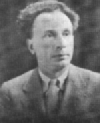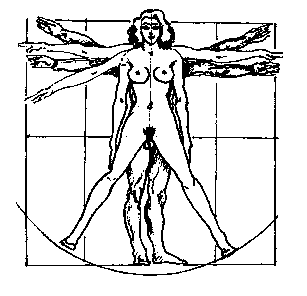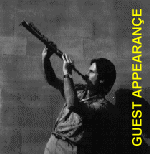

 This is my diary of events that relate to the How Say You exhibition.
Of the five billion people in the world, you might be one of the aberrant few who are
interested in the fate of this inquiry. To satisfy your curiosity, this page will include
responses to the exhibition during the course of its various manifestations. Please feel
free to contact the owner with your own.
This is my diary of events that relate to the How Say You exhibition.
Of the five billion people in the world, you might be one of the aberrant few who are
interested in the fate of this inquiry. To satisfy your curiosity, this page will include
responses to the exhibition during the course of its various manifestations. Please feel
free to contact the owner with your own.
Preview - Opening - Kathy
Acker - Galatea- Paul Kane - Hypothetical - The Brush-Off - A Physicist Deconstructs Cultural Studies - Adelaide
Daubists - Faylene Rheem - Guest appearance
- Tasmania
Writer Jacqueline Millner publishes article in Real Time `The law and the arts: accomplices'. She uses the exhibition as an opportunity to compare the processes of the court and the gallery:
it may be that legal structures underpin the way we view works of art, the way we judge them, the way we look for that quality which singles out art in the popular understanding - a unique, authentic voice or creative spirit - before we can safely bestow our awe. Both the law and art are concerned with authenticity, although both can be satisfied with authentic inauthenticity, and both decidedly lose their sense of humour if someone blows the whistle so that an endorsed veracity is suddenly revealed as perjury and fraud.
Lawyer and columnist Moira Rayner opened with the exhibition with a witty and touching speech. She spoke of barristers as themselves fictional beings and recounted the tale of Victor, the New Zealand inventor of the `death ray' who ended his life as a preacher.
American writer Kathy Acker emails that she will let other people use her persona: `I think it fun and rather a relief'. She admitted knowing at least one man who has given readings in her name. `I didn't mind at all. If I did...it would be rather hypocritical'.
Robert Rooney's review in The Australian was an erudite but unguided piece of writing that failed to make any general judgment on the exhibition. Includes this quote from Hyacinth Eshol (1969) regarding Sandra Bridie's work: `When in the position where nothing definite can be done and wanting to do something, then let someone make the content of your next work for you, on the basis of your previous works.' Is Hyacinth Rooney's own contribution to the fictional pantheon?
Barbara Campbell's performance occurred on a wet autumn night at ACCA. The video showed excerpts from Anthony Asquith's 1938 film version of George Bernard Shaw's Pygmalion, where Eliza Doolittle (Wilfred Lawson) is attempting to master the Queen's English under Professor Higgins (Leslie Howard) stern instruction. Dubbed over the images are the sounds of a woman being instructed in the correct pronunciation of Italian. As the video fades out, an elegantly dressed woman enters the gallery and sits on a Barcelona chair, turns on a Fluxus light, takes a sip from Farrarelle mineral water, and begins reading an Italian translation of Katharine Suzanna Prichard's Il Cooboo.
There is an intriguing ambiguity in Campbell's performance. Her pronunciation of Italian (the result of a mere three months instruction) is flawless and spirited. Hearing local vocabulary--such as Aboriginal words and Australian slang--through Italian vocalisation evokes a foreign consciousness in our own backyard. So long a consumer of world culture, it is surprising to witness a player on the world stage (Italy) make a drama out of its audience (Australia). Yet, this spell is occasionally broken as the muffled audience sounds in the gallery remind us that we are looking at a performance artist impersonating an Italian. She is one of us, after all. Or is she?
The story finishes and she closes the book, turns the video back on and leaves the gallery. The video then shows the scene from Pygmalion when an `expert' in elocution spots Ms Doolittle as a `fake' because `she speaks English too well for a real English lady' and claims that she is a Hungarian princess.
If you believe in Galatea, then you would claim that deliberate and public falsehood opens a way to the heart of things.
American academic argues in a recently published book (Australian Poetry: Romanticism and Negativity Cambridge) that Ern Malley--`a poet unsullied by existence'-- is indicative of the absence of romantic tradition in Australia. The negativity of non-being is the indigenous response to the social isolation celebrated by true romantics elsewhere--or so he says.
There was a full house at the former Melbourne Magistrate's Court to hear a panel of legal, literary and art gatekeepers navigate a hypothetical scenario steered by Susanna Lobez (Radio National law report). The panel sat up at the bench, the moderator from the assistant's desk and the reader from the witness box.
The scenario was generous complimented by spontaneous co-scripting from particular members. Literary editor Morag Fraser found appropriate pseudonyms for the various literary magazines in Australia.
In terms of the general question, a clear difference did emerge between the nature of fraud in literature and visual art. While the `sting' of deception might be easily accommodated into contemporary `conceptual art', such an act can only be seen as a hostile one in the literary arts. Why might this be so?
The lawyers in the evening were very moderate in their advice. There was no strong claim on behalf of the slighted audience, Macassans or purchasers of books and art. Perhaps if there had been a Macassan in the audience, things would have been different.
Local author Shane Maloney launches his new murder mystery The Brush-Off where Labour Party secretary Murray Whelan attempts to solve an art murder mystery centred around an institution named the Museum of Contemporary Art, known in real life as the Australian Museum of Contemporary Art, where How Say You, the exhibition containing Peter Hill's art murder mystery, was launched.
Alan D. Sokal from the Dept. of Physics at New York University has pulled off what appears to be an Ern Malley subterfuge in the journal Social Text. To quote from his statement:
How did I do it? I structured the article by inventing
an ``argument'' linking Derrida, Lacan, Irigaray, and quantum gravity. I then threw in,
for good measure, a pinch of feminism, a dab of multiculturalism, and a sprinkling of New
Age ecology. All this was quite easy to carry off, since my argument wasn't obliged to
respect any standards of evidence or logic.
I intentionally wrote the article so that any competent physicist (or undergraduate
physics major) would quickly realize that it is a spoof. Evidently the editors of Social
Text felt comfortable publishing an article on quantum physics without bothering
to consult anyone knowledgeable in quantum physics.
In response to an email inquiry, a lengthy statement was sent from the editor of Social
Text, Andrew Ross. In his defense of the unrefereed journal, he outlined the context
for their decision first to publish Sokal's article:
As the work of a natural scientist it was unusual, and, we thought, plausibly symptomatic of how someone like Sokal might approach the field of postmodern epistemology i.e. awkwardly, assertively, and somewhat aimlessly, with a veritable armada of footnotes to ease his sense of vulnerability. In other words, we read it more as an act of good faith of the sort that might be worth encouraging than as an exercise of the intellect whose scholarly worth had to be judged. On those grounds, the editors considered that it might be of interest to readers as a "document" of that time-honored tradition in which modern physicists have discovered harmonic resonances with their own reasoning in the field of philosophy and metaphysics.
As you might notice, the initial act of publication itself was intended not as a serious presentation of ideas but rather as an ironic comment on the trajectory of ideas into the natural sciences. Who is going to have the last laugh?
In 1988, the French sociologist Bruno Latour asked that the journal Social Problems publish his article `Mixing humans with non-humans: The sociology of the door-closer' under the name Jim Johnson. This was a response to the editorial direction that `no America sociologist is willing to read things that refer to specific places and times which are not American'. The psuedonym also helped his argument, which concerned the practice of delegation in technology.
Alan Sokal, however, chose to keep his real name while indulging his readers with scientific fiction. What then happens to his credibility as a physicist, to have professed deliberate scientific untruths?
How Say You opens in the University of South Australia Art Museum (Underdale) amid talk of a name change for the state. `New Bavaria' is one of the fancied titles at this point in time.
Adelaide has a rich history of deviations from authorship. This was the city which first published the poetry of Ern Malley in 1943. More recently, it is the home not only of Lana H. Foil but also the daubists, a self-mythologised art movement whose signature is the creative defacement of works of art (cf. Duchamp's Mona Lisa). Their manifesto reads as follows:
to challenge the notion of `Authorship'
to open every action to Daubist re-action
to construct through metamorphosis
to relegate and furphify
to delegate the meaning to you to re-negotiate
to denounce the catalogue essay
to reject Art Cabals
to be the new by the use of the old
to Daub or NOT to Daub...
Thanks to Antoinette de Shaaft and Broadsheet (21/5 Dec'92) and thank goodness for the safety of Internet.
How Say You has been petitioned about the absence of Faylene Rheem, Australia's most notorious feminist artist and author of How to Draw Women, an illustration from which appears below.
 While the artists selected for How Say You were guilty of crimes
against individual creativity, it is clear that the actions of Ross Woodrow serve a
clearly identified particular ideological end, for which we disagree most strongly - but
it is a palpable end nonetheless.
While the artists selected for How Say You were guilty of crimes
against individual creativity, it is clear that the actions of Ross Woodrow serve a
clearly identified particular ideological end, for which we disagree most strongly - but
it is a palpable end nonetheless.
 A Polish
musician keeps appearing at strategically inappropriate moments during the course of the
tour, prompting attention of the thought police. If you recognise this artistic virus,
please contact the appropriate authorities (and then contact me to tell me who those
authorities are - we'd all like to know).
A Polish
musician keeps appearing at strategically inappropriate moments during the course of the
tour, prompting attention of the thought police. If you recognise this artistic virus,
please contact the appropriate authorities (and then contact me to tell me who those
authorities are - we'd all like to know).
The celebrated curator of the Tasmanian Museum and Art Gallery pointed out the
publication dedicated to the talented Rennaissance painter who by fate remains nameless:
When the Sainsbury Wing was being built, the architects were keen that we should pu on
the staircase a frieze of the names of the half-dozen greatest Renaissance artists. You
may imagine their alarm when I suggested that one of those six out to be The Master of the
Saint Bartholemew Altarpiece. Indeed, I do not believe they thought I was being serious.
So no German artist, is present in our frieze. The north, when it comes to names, is
doomed always to low to the Italians.
Neil Macgregor (A Victim of Anonymity, 1993, p. 17)
Thanks to the generous efforts from an impressive panel of gatekeepers, the hypothetical was successfully unravelled at the Hobart Criminal Court and Penitentiary Chapel. The proceeding opened dramatically with the entry of the panel from an underground passage leading up to the docks. In the end, a certain Green politics disowned the new Situationist-style action suggested by the hypothetical. For more, read The Secret Life of Francis Geyer.
Dede Pol
© 1996